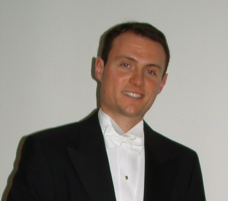High Speed Photodiodes in standard CMOS technology
Promotion Date: 1 December 2004
| Let me start by explaining the abbreviation in the thesis title. CMOS technology is a standard (straightforward) chip technology. Photodiodes in the title presents converters which convert a light into electronic signal. However, not the light from the daily environment but the light coming from the optical fiber. Optical fibers are used to send the information signal on long distances with a high-speed (a few bilion bits/second). Photo diodes catch the light and converts it to an electrical signal processed further with the electronic circuitry. |
What was your thesis about?
Let me start by explaining the abbreviation in the thesis title. CMOS technology is a standard (straightforward) chip technology. Photodiodes in the title presents onverters which convert a light into electronic signal. However, not the light from the daily environment but the light coming from the optical fiber. Optical fibers are used to send the information signal on long distances with a high-speed (a few bilion bits/second). Photo diodes catch the light and converts it to an electrical signal processed further with the electronic circuitry.
Nowadays detectors for long-distance optical communication are mainly implemented in dedicated (and therefore expensive) technologies. The usage of these expensive system is justifed by the large number of users such as large number of companies, universities etc. The cost per user is low.
Suppose you want to communicate in the short distance, between two computers for instance or even between two ports inside a computer, using optical signals. It definitely is an option, because the possible speed of electrical wire communication will soon reach their limit, whereas the optical communication has an enormous bandwidth and a thousand times greater speed is possible. But then you would need something to transmit the signal through the fibre and to catch the signal with the electronic circuits. That has to beihowever inexpensive, because the standard electronics are nowdays very cost-effective. My part of the research was to design the detectors; the receiving part that catches the light from the optical fibre converting it to a electronic signal. The speed I am now talking about is more than a billion bits per second. But the converter in CMOS is one hundred times slower. So in fact you are back to square one. So my PhD task was to increase the speed op the converter.
And did you succeed?
I finish the project by increasing the speed even 300 times more. The solution is the result of the combined effects in physics of the photodiodes and the electronic circuit itself.
How far are we off from this new type of computer?
Over the last five years the speed of microprocessors in computers are not increasing at the same rate as before, that means they are slowing down. There are various reasons for that, not only electronics being at its limit.
The consumer market is very important market for computers, and the ordinary user is not inclined to buy a computer with a higher speed. He simply does not need it. First the applications have to be developed that actually demand a higher speed, then the hardware will follow and only then it is commercially worth-while to implement this new technology.
But still an inexpensive transmitter (that sends the light into the fibre) and cheap connectors remain to be developed.
Is there no demand for high speed computers in science and trade and industry?
There is definitely, but if these cannot be mass-produced, they will be too expensive.
Did you travel a lot during your PhD?
Yes. When we designed this chip and it worked, it was a nice opportunity for me to present it world-wide. So I went to several conferences in San Francisco, Hong Kong, Taiwan, Portugal.
What do you do now?
I have a job in Delft. I am working in the american company called National Semiconductor. They have their office here in the Netherlands. I am working as a chip designer.
Do you apply the outcome of your research in your present work?
Now I am working more on the transmission part. I am now working on the chip that drives the laser which will be used in future DVD recorders.
Where are you coming from?
I am coming from Serbia-Montenegro.
Did you enjoy doing your PhD in the Netherlands?
I certainly did. It was a great experience. There are much more research possibilities here than in my own country and more money is available for research. That means that you have the necessary equipment for making and testing your designs. The science is very much connected with the industry here. The only thing at the beginning was that I had to get used to a different environment, but that is a thing you easily accept. Of course I was also missing my friends and family.
But now you are staying in the Netherlands?
Yes, and the things have changed. I am married now and I have a little daughter. So my family life is here. I am used to the Netherlands but nevertheless, home is still home.
For more information see http://icd.el.utwente.nl/persons/index.php?id=25
For the summary of the thesis and the biography, click here. (English/Dutch)

